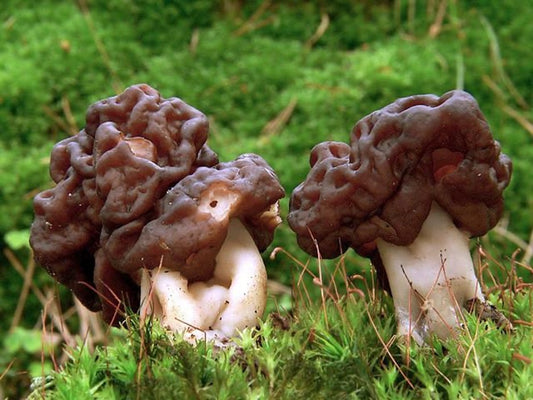Are Mushrooms Vegetables And If Not, Why?
If you are contemplating the question “are mushrooms vegetables?”, realize mushrooms are not plants so they are not considered to be vegetables. Mushrooms are a type of fungi, putting them in a completely different category from plants. While mushrooms have some similarities to vegetables, such as being edible and having nutritional value, there are many differences that distinguish them from the plant kingdom.
Are Mushrooms Vegetables?
No, mushrooms are not vegetables. Mushrooms lack chlorophyll, the pigment in plants responsible for photosynthesis, making them unable to produce their own food as plants do. Mushrooms reproduce differently than most plants and rely on spores rather than seeds for reproduction.
Mushrooms are more similar to animals than they are to plants, as they breathe in oxygen and exhale carbon dioxide. Mushrooms typically feast on dead organisms, breaking down the decomposing matter into nutrients plants can use. Mushrooms contain many unique, health-benefiting compounds that plants do not have.

Were Mushrooms Ever Classified As Vegetables?
If you were reading this in the year 1968, the answer to the question “are mushrooms vegetables?” would be yes. However, in 1969, the fungi kingdom was proposed by Robert Harding Whittaker. Upon consensus, mushrooms were removed from the plant kingdom and added to the newly formed fungi kingdom. (Three Reasons Fungi Are Not Plants, 2021)
Mushrooms Are Vegetables According To The USDA
Mushrooms are still classified as vegetables by the United States Department of Agriculture (USDA) because they contain essential vitamins and minerals that are necessary for a healthy diet. (Vegetables | MyPlate, 2023) However, technically speaking, mushrooms and vegetables are completely different from each other.
The Difference Between Mushrooms And Vegetables
Most mushrooms obtain their nutrition from decaying plant material, living or dead organisms, or organic matter in the soil. (Dion, 2022) They decompose these sources of food, absorbing all the necessary nutrients in the process. Mushrooms are often found growing on logs, stumps, and trees absorbing nutrients directly from them.
Mushrooms have a significant ecological role in forest environments because they break down tough materials like wood, helping recycle vital nutrients back into the ecosystem. They also provide food for larger animals like deer and bears who rely on them as an important source of sustenance.
On the other hand, plants use photosynthesis to produce their own energy in the form of sugar. Plants store that sugar and rely on these energy stores when they need to.
Are Mushrooms Vegetables – Difference Between Seeds And Spores
Plant seeds and mushroom spores have some similarities, such as both are capable of producing new life forms. However, they also have some distinct differences that set them apart. Plant seeds contain all the nutrients necessary for a plant embryo to grow and develop. They typically consist of an outer coating that protects the developing organism within, along with food reserves in the form of endosperm or cotyledons, depending on the species. The seed will eventually germinate when it receives sufficient water and light.
In contrast, a mushroom spore is a single cell containing genetic information from its parent organism. It does not contain any nutrition and must find its own food source once it lands in a suitable environment. When conditions are favorable, the spore will germinate, forming a thread-like structure known as a hypha that expands and can eventually produce mushrooms. Spores are lightweight and can easily be carried away by the wind or water, helping to disperse the mushroom population.
Some species of mushroom require two spores for successful germination, whereas a single seed is typically all that is needed for a plant to grow. Together, these differences highlight the remarkable diversity of life found on our planet.

Are Mushrooms Vegetables – The Differences in Respiration
Plants perform photosynthesis, which is a process of converting light energy from the sun into stored chemical energy in the form of sugar molecules. Oxygen is a byproduct of this process, while carbon dioxide acts as an input for photosynthesis.
The opposite occurs with mushrooms: they release carbon dioxide through respiration and absorb oxygen to produce energy. In summary, plants take in carbon dioxide and give off oxygen during their respirational cycle, whereas mushrooms do the opposite – taking in oxygen and giving off carbon dioxide instead.
Mushrooms and humans both depend on the exchange of oxygen and carbon dioxide to survive. In the same way that a human breathes in oxygen and exhales out carbon dioxide, mushrooms do the same process through their cells called mycelia. This process allows mushrooms to obtain the energy needed for growth and development.
Are Mushrooms Vegetables – Life Cycle Differences
Plants have complex life cycles involving germination, flowering, pollination, and seed production, while mushrooms typically only have a few stages of growth including primordial (first stage), pinning (second stage) and maturity (third stage).
Plants typically have a stem, leaves, and roots while mushrooms lack stems and roots, instead having a fruiting body consisting of a cap and stalk.
The lifespan of a mushroom is much shorter than that of plants. Most mushrooms only last for days or weeks, while plants can survive for many years with proper care and nutrition.
How Mushrooms And Plants Help Each Other
Different species of fungi help form symbiotic relationships with plants. Mycorrhizal fungi, for example, form a partnership with trees and other plant species to give them increased access to essential nutrients.
Specifically, mycorrhizal fungi form a mutualistic relationship with the plant roots, exchanging water and minerals from the soil for carbohydrates from the plant. This helps the plant access nutrients that it otherwise wouldn’t be able to get by itself. (Mycorrhizae, 2022)
Without mushrooms, these vital ecosystems would be drastically altered.
Health Benefits Of Mushrooms
Mushroom cultivation is becoming increasingly popular due to the numerous health benefits they offer. Mushrooms are low in calories and fat, yet provide essential nutrients such as Vitamin D, which is important for maintaining healthy bones and teeth, as well as aiding in the absorption of calcium.
They also contain B vitamins, including niacin and folate, which help with energy production and metabolism in the body. Additionally, selenium, copper, and pantothenic acid are found in mushrooms, which can help protect against oxidative damage to cells and tissue. (Valverde et al., 2015) Essentially, mushrooms provide a wealth of vital nutrients that can have many beneficial effects on the body.
Studies have found that mushrooms are high in polyphenols (antioxidants) which can help protect against certain cancers, heart disease, obesity, and other chronic diseases. (Duthie et al., 2000) (Wang et al., 2014)
Mushrooms Have Glutathione And Ergothioneine
Mushrooms contain two very important antioxidants that benefit overall health and wellness: glutathione and ergothioneine. Glutathione is essential for detoxification, fighting inflammation, and protecting cells from the damaging effects of free radicals.
Ergothioneine helps protect cellular components from oxidative stress and has been linked to improved immunity, cardiovascular health, eye health, and brain function. Ergothioneine is a powerful antioxidant and anti-inflammatory agent, making it a great addition to any health regimen. It may help reduce inflammation in the body, which can lead to improved overall health and improved mental health. (Kalaras et al., 2017)
Ergothioneine has also been associated with better eye health, lower risk of cancer, and improved brain function. Studies have indicated that ergothioneine may be beneficial for skin health by helping to protect against environmental damage such as sun exposure. Finally, research suggests that ergothioneine could help protect against oxidative stress and promote healthy longevity. Low ergothioneine levels are associated with developing Parkinson’s disease, Alzheimer’s disease, and depression. (Cheah & Halliwell, 2021)
All in all, ergothioneine offers many potential health benefits when included as part of an overall balanced diet and active lifestyle
Mushrooms Contain Beta-Glucans
Mushrooms contain beta-glucans, a type of dietary fiber with potential health benefits. Beta-glucans have been studied for their potential health benefits, including helping to regulate blood sugar levels, boosting immunity, and aiding digestion. Studies show that beta-glucans may even help protect against cancer and reduce inflammation. (Cerletti et al., 2021) It’s clear that adding more beta-glucans to your diet could be beneficial for your overall health.
Mushrooms Contain Vitamin D While Vegetables Don’t
Mushrooms are an excellent source of vitamin D. Vitamin D is important for the body, as it helps with calcium absorption, bone health, and muscle function. Mushrooms contain ergosterol, which is converted in the human body into vitamin D2 when exposed to UV radiation.
When selecting mushrooms for their vitamin D content, look for varieties such as oyster, shiitake, or maitakemushrooms. These three types have high concentrations of ergosterol and can provide up to 100 international units (IU) of vitamin D per 100 grams. When buying mushrooms, opt for those raised in direct sunlight or exposed to UV radiation for at least five hours. These mushrooms will contain higher levels of vitamin D. (Cardwell et al., 2018)
Mushrooms Contain Chitin While Plants Don’t
Chitin is a type of carbohydrate found in the cell walls of fungi, including mushrooms. It is made up of long chains of polysaccharides that give mushrooms their structure and rigidity. Besides providing structure to mushrooms, chitin has many other properties that make it beneficial for humans.
For example, chitin can help regulate blood sugar levels and cholesterol levels in the body, as well as promote digestion and gut health. Additionally, studies suggest that chitin may even have anti-inflammatory and antimicrobial benefits. All in all, consuming mushrooms on a regular basis provides numerous health benefits thanks to their high content of chitin. (Jayachandran et al., 2017) (Bokura & Kobayashi, 2003)

Mushrooms Or Plants – Which Inhabited Planet Earth First?
The debate over which organism appeared first on planet Earth is still ongoing. Some believe that fungi preceded plants, while others argue that plants came before fungi.
One argument in support of the idea that fungi came before plants are that the oldest fossil evidence for life on Earth comes from the fossils of a fungus-like organism known as Grypania spiralis. This ancient organism was discovered in stromatolite deposits at the Gunflint Formation in Canada, and it dates back to 2 billion years ago.
Additionally, some researchers claim that more complex forms of fungi were living around 1.5 billion years ago.
On the other hand, there are also several pieces of evidence supporting the notion that plants evolved before fungi. For example, some scientists argue that the presence of plant-like fossils in Australia from 1.6 billion years ago suggests that plants were living on Earth before fungi. Furthermore, studies suggest that there may have been more complex forms of algae present around 1.2 billion years ago.
The debate over which organism first appeared on Earth is ongoing, but they are both necessary for our survival. (First Land Plants and Fungi, 2020) (Brophy, 2021)
Are Mushrooms Vegetables, Or Are They More Similar To Fruits?
Mushrooms and fruits share a similar physical structure in that they are both composed of edible reproductive bodies. Mushrooms produce spores, which are released much like the seeds of a fruit, while fruits develop from flowers and may have seeds inside their pulpy walls.
Both mushrooms and fruits provide dietary fiber, as well as plenty of antioxidants to help keep us healthy. In addition, because most mushrooms and many fruits can be eaten raw, they provide our bodies with plenty of live enzymes for better digestion. Finally, both mushrooms and fruits play an important role in helping to recycle nutrients back into the soil to promote healthy ecosystems.
Are Mushrooms Vegetables?
Though mushrooms are not classified as a vegetable, they are often eaten as part of a healthy diet due to their high levels of protein, iron, and B vitamins. They can add flavor and texture to dishes ranging from salads to pizza and can be used as a meat substitute in vegetarian dishes. So while mushrooms are not vegetables, they are an excellent choice for those looking to incorporate healthy foods into their diet.
In the end, whether or not you classify mushrooms as vegetables doesn’t really matter as long as you are eating them and getting all the health benefits that only mushrooms can provide.
Mushrooms aren’t vegetables, but fungi and plants both complement each other to maintain a perfect ecological balance. Furthermore, the consumption of both mushrooms and vegetables is critical to maintaining good health, as each contains unique nutritional compounds. If you want to grow your own mushrooms, consider starting out with our oyster mushroom grow kit or lion’s mane grow kit which can be a fun, healthy hobby.
References
Three Reasons Fungi Are Not Plants. (2021). ASM.org. https://asm.org/Articles/2021/January/Three-Reasons-Fungi-Are-Not-Plants
Vegetables | MyPlate. (2023). https://www.myplate.gov/eat-healthy/vegetables
Dion, D. (2022, October 2). Saprotrophic Mushrooms: Nutrients From Dead Or Decaying Organic Matter – Wsmbmp. https://wsmbmp.org/. https://wsmbmp.org/saprotrophic-mushrooms-nutrients-from-dead-or-decaying-organic-matter/
Mycorrhizae- The Symbiotic Relationship between Fungi and Roots. (2022, June 8). https://bio.libretexts.org/@go/page/13792
Valverde, M. E., Hernández-Pérez, T., & Paredes-López, O. (2015). Edible mushrooms: improving human health and promoting quality life. International journal of microbiology, 2015, 376387. https://doi.org/10.1155/2015/376387
Duthie, G., Duthie, S., & Kyle, J. (2000). Plant polyphenols in cancer and heart disease: Implications as nutritional antioxidants. Nutrition Research Reviews, 13(1), 79-106. doi:10.1079/095442200108729016
Wang S, Moustaid-Moussa N, Chen L, Mo H, Shastri A, Su R, Bapat P, Kwun I, Shen CL. Novel insights of dietary polyphenols and obesity. J Nutr Biochem. 2014 Jan;25(1):1-18. doi: 10.1016/j.jnutbio.2013.09.001. PMID: 24314860; PMCID: PMC3926750.
Kalaras MD, Richie JP, Calcagnotto A, Beelman RB. Mushrooms: A rich source of the antioxidants ergothioneine and glutathione. Food Chem. 2017 Oct 15;233:429-433. doi: 10.1016/j.foodchem.2017.04.109. Epub 2017 Apr 20. PMID: 28530594.
Cheah, I. K., & Halliwell, B. (2021). Ergothioneine, recent developments. Redox biology, 42, 101868. https://doi.org/10.1016/j.redox.2021.101868
Cerletti C, Esposito S, Iacoviello L. Edible Mushrooms and Beta-Glucans: Impact on Human Health. Nutrients. 2021 Jun 25;13(7):2195. doi: 10.3390/nu13072195. PMID: 34202377; PMCID: PMC8308413.
Cardwell G, Bornman JF, James AP, Black LJ. A Review of Mushrooms as a Potential Source of Dietary Vitamin D. Nutrients. 2018 Oct 13;10(10):1498. doi: 10.3390/nu10101498. PMID: 30322118; PMCID: PMC6213178.
Jayachandran M, Xiao J, Xu B. A Critical Review on Health Promoting Benefits of Edible Mushrooms through Gut Microbiota. Int J Mol Sci. 2017 Sep 8;18(9):1934. doi: 10.3390/ijms18091934. PMID: 28885559; PMCID: PMC5618583.
Bokura H, Kobayashi S. Chitosan decreases total cholesterol in women: a randomized, double-blind, placebo-controlled trial. Eur J Clin Nutr. 2003 May;57(5):721-5. doi: 10.1038/sj.ejcn.1601603. PMID: 12771974.
First Land Plants and Fungi Changed Earth’s Climate, Paving the Way for Explosive Evolution of Land Animals, New Gene Study Suggests | Eberly College of Science. (2020, August 4). https://science.psu.edu/news/first-land-plants-and-fungi-changed-earths-climate-paving-way-explosive-evolution-land-animals
Brophy, E. (2021, October 16). Oxygen as an evolutionary constraint – Understanding Evolution. Understanding Evolution – Your One-stop Source for Information on Evolution. https://evolution.berkeley.edu/evo-news/oxygen-as-an-evolutionary-constraint/



